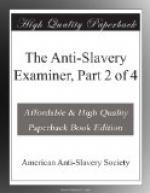3. Under this government, servants were to be universally and heartily obedient; and both in the presence and absence of the master, faithfully to discharge their obligations. The master on his part, in his relations to the servants, was to make JUSTICE AND EQUALITY the standard of his conduct. Under the authority of such instructions, slavery falls discountenanced, condemned, abhorred. It is flagrantly at war with the government of God, consists in “respect of persons” the most shameless and outrageous, treads justice and equality under foot, and in its natural tendency and practical effects is nothing else than a system of wrong-doing. What have they to do with the just and the equal who in their “respect of persons” proceed to such a pitch as to treat one brother as a thing because he is a servant, and place him, without the least regard to his welfare here, or his prospects hereafter, absolutely at the disposal of another brother, under the name of master, in the relation of owner to property? Justice and equality on the one hand, and the chattel principle on the other, are naturally subversive of each other—proof clear and decisive that the correlates, masters and servants, cannot here be rendered slaves and owners, without the grossest absurdity and the greatest violence.
“The relation of slavery,” according to Prof. Stuart, is recognized in “the precepts of the New Testament,” as one which “may still exist without violating the Christian faith or the church."[A] Slavery and the chattel principle! So our professor thinks; otherwise his reference has nothing to do with the subject—with the slavery which the abolitionist, whom he derides, stands opposed to. How gross and hurtful is the mistake into which he allows himself to fall. The relation recognized in the precepts of the New Testament had its basis and support in “justice and equality;” the very opposite of the chattel principle; a relation which may exist as long as justice and equality remain, and thus escape the destruction to which, in the view of Prof. Stuart, slavery is doomed. The description of Paul obliterates every feature of American slavery, raising the servant to equality with his master, and placing his rights under the protection of justice; yet the eye of Prof. Stuart can see nothing in his master and servant but a slave and his owner. With this relation he is so thoroughly possessed, that, like an evil angel, it haunts him even when he enters the temple of justice!
[Footnote A: Letter to Dr. Fisk, supra p. 7.]
“It is remarkable,” with the Princeton professor, “that there is not even an exhortation” in the writings of the apostles “to masters to liberate their slaves, much less is it urged as an imperative and immediate duty."[B] It would be remarkable, indeed, if they were chargeable with a defect so great and glaring. And so they have nothing to say upon the subject? That not even the Princeton




